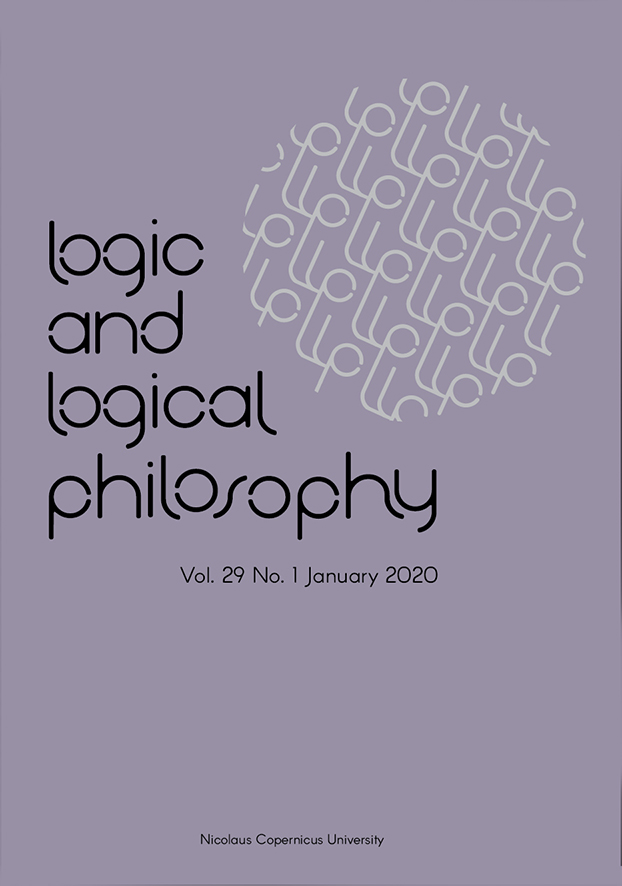Time and Physical Geometry. A Formalization of Putnam’s Proof
DOI:
https://doi.org/10.12775/LLP.2019.021Keywords
time flow, eternalism, relativity, simultaneity, spacetimeAbstract
Putnam’s proof that time flow is incompatible with Relativity is underestimated, mostly due to Stein’s interpretation of the notion of reality in it as a two-term relation. This interpretation makes it vulnerable to easy criticism and makes various ways of escaping its conclusion possible. An alternative approach is proposed, resulting in a formalization which seems closer to Putnam’s intentions where reality is interpreted as a non-relational property. Although it makes the proof immune to all standard strategies of blocking the proof, it reveals its real weak point which consists in assuming an overly strong interpretation of the principle of relativity.References
Bell, J.S., “How to teach special relativity”, pages 67–80 in J.S. Bell, Speakable and Unspeakable in Quantum Mechanics, Cambridge, Cambridge Univ. Press, 2004. DOI: http://dx.doi.org/10.1017/CBO9780511815676.011
Carter, B., “Causal structure in space-time”, General Relativity and Gravitation 1, 4 (1971): 349–391. DOI: http://dx.doi.org/10.1007/BF00759217
Czerniawski, J., “Teoria względności a upływ czasu”, Filozofia Nauki 2, 1 (1994): 95–100.
Czerniawski, J., “Nowa formalizacja dowodu Putnama, że czas nie płynie”, Filozofia Nauki 22, 1 (2014): 45–57.
Davies, P.C.W, and J.S. Bell, “John Bell” (interview with), pages 45–57 in P.C.W. Davies and J.R. Brown (eds.), The Ghost in the Atom: A Discussion of the Mysteries of Quantum Physics, Cambridge, Cambridge Univ. Press, 1986.
Denbigh, K., Three Concepts of Time, Berlin, Springer, 1981. DOI: http://dx.doi.org/10.1007/978-3-642-68082-3
Dieks, D., “Special relativity and the flow of time”, Philosophy of Science 55, 3 (1988): 456-460. DOI: http://dx.doi.org/10.1086/289452
Eilstein, H., “Prof. Shimony on “the transient Now””, Synthese 107, 2 (1996): 223–247. DOI: http://dx.doi.org/10.1007/BF00413607
Forrest, P., “The real but dead past: a reply to Braddon-Mitchell”, Analysis 64, 4 (2004): 358–62. DOI: http://dx.doi.org/10.1093/analys/64.4.358
Hinchliff, M., “The puzzle of change”, Noûs 30 (Supplement) (1996): 119–16. DOI: http://dx.doi.org/10.2307/2216239
James, W., The Principles of Psychology, vol. 1, London, MacMillan, 1891.
Lorentz, H.A., “The principle of relativity for uniform translations (1910–1912)”, pages 179–211 in H.A. Lorentz, Lectures on Theoretical Physics, vol. 3, London, MacMillan, 1931.
Maudlin, T., The Metaphysics Within Physics, Oxford, Oxford University Press, 2007. DOI: http://dx.doi.org/10.1093/acprof:oso/9780199218219.001.0001
Putnam, H., “Time and physical geometry”, Journal of Philosophy 64, 8 (1967): 240–247. DOI: http://dx.doi.org/10.2307/2024493
Putnam, H., “Reply to Mauro Dorato”, European Journal of Analytic Philosophy 4, 2 (2008): 71–73.
Sarkar, S., and J. Stachel, “Did Malament prove the non-conventionality of simultaneity in the special theory of relativity?”, Philosophy of Science 66, 2 (1999): 208–220. DOI: http://dx.doi.org/10.1086/392684
Savitt, S., “The transient nows”, in W. Myrvold and J. Christian (eds.), Quantum Reality, Relativistic Causality, and Closing the Epistemic Circle: Essays in Honour of Abner Shimony, Berlin, Springer, 2009. DOI: http://dx.doi.org/10.1007/978-1-4020-9107-0_18
Sider, T., Writing the Book of the World, Oxford, Oxford University Press, 2011. DOI: http://dx.doi.org/10.1093/acprof:oso/9780199697908.001.0001
Stein, H., “On Einstein-Minkowski space-time”, Journal of Philosophy 65, 1 (1968): 5–23. DOI: http://dx.doi.org/10.2307/2024512
Downloads
Published
How to Cite
Issue
Section
Stats
Number of views and downloads: 1126
Number of citations: 0







